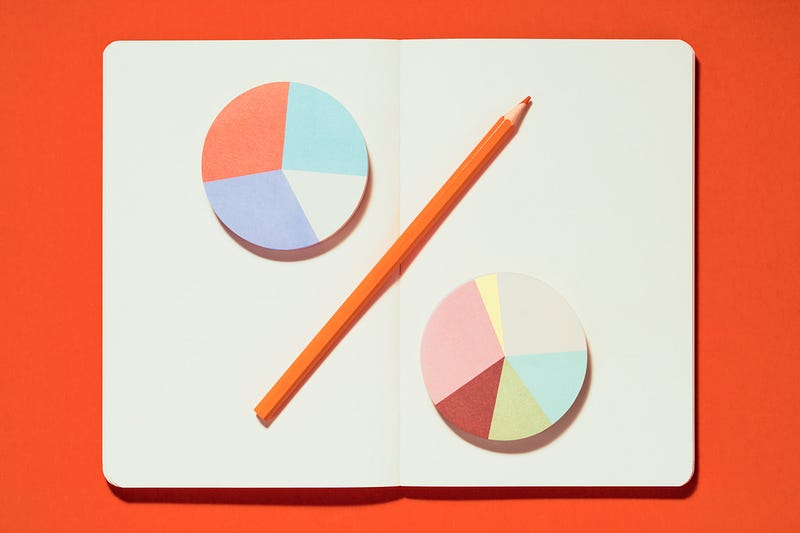Math Hacks for Back-to-School Shopping: Percentages and Discounts

The first page of a crisp new notebook, the initial *click* of a fresh pen, the squeak of breaking in a new pair of shoes… all true hallmarks of going back to school. But before those core memories can happen, there’s another important season that’s just as much fun, in our opinion:
Back-to-school shopping!
Whether you’re shopping online or at a store with your friends, there’s a sort of electricity when you’re shopping for a new school year. Finding the perfect planner or your ideal first day outfit can be super exciting, but it can also get expensive fast — and, therefore, kinda stressful.
When you’re doing that much shopping, numbers are important. And that means math is important, too!
The math behind back-to-school shopping
We’ve mentioned before that there’s math everywhere, even where you might not expect it — but with shopping, you don’t need to dig too deep to see the math that lies beneath.
When you’re making a back-to-school budget, you’ll need to use core fundamentals like addition and multiplication. Then, once you start shopping and hit all the back-to-school sales, you’ll use percentages, decimals, and more arithmetic.
Maybe focusing on math doesn’t make back-to-school shopping sound as fun, but trust us: shopping the sales is a lifelong skill you’ll want to have. When you take advantage of sales and discounts, you make your budget stretch further!
So let’s make sure you get the most for your money, shall we?
How to calculate a discount percentage
If you’re figuring out discounts while you shop, you’re doing math on the fly! In addition to basic arithmetic, here are the main concepts to remember for calculating discounts:
Converting percentages to decimals
You’ll typically see sales as percentages: 60% off, 15% savings, save 20%.
If your phone or calculator doesn’t have a “%” button, you’ll need to convert the percentage to a decimal number before you can calculate anything. Remember that if you don’t see a decimal point, it’s at the end of the number (“60” as a decimal is “60.0”); when we convert a percentage to a decimal number, we move the decimal point to the left twice (so 60% = 0.60, or 0.6).
Multiplying an integer by a decimal (or multiplying two decimals)
You’ll be multiplying your decimal by the original price to find the discount amount. For example, to find 60% of $30, you’d multiply the integer by the decimal number: 30 x 0.6.
Or, if it was 60% off $29.99, you’d calculate 29.99 x 0.6 to find your discount amount — so you’d need to multiply two decimal numbers.
Then you’d subtract that amount from the original price to find the sale price (there’s that arithmetic again!).
It can sound complicated if you get too bogged down in the math terms, so let’s walk through an example:
Example
You want to see how much you’ll pay for a pack of pens. It’s normally $10, but it’s on sale for 20% off. How much would you pay for the pack of pens at the sale price?

But this isn’t the only way to calculate a discount! In fact, we have a few tricks that can level up your mental math.
Math hack: Find the final price faster
This is a simple swap that can make a big difference when you’re doing mental math in the middle of a back-to-school sale!
Normally, we work with the numbers we have and calculate from there, like in the discount method we just reviewed: We see a $10 pack of pens on sale for 20% off, so we find 20% of 10, then subtract that result from $10 to get the final sale price ($8). But it’s common to get tripped up and forget to subtract the result of your multiplication — so you end up thinking the discount amount is the sale price, which can be pretty disappointing at checkout. That’s why we love this math hack we’re about to share!
Although the sale is for 20% off, we’re not limited to just that percentage (calculating what we’d save). The full price represents 100%, so instead, we can find the value of the remaining 80% (what we’d actually pay). This streamlines our process a bit more, so that we’re focused on the final price from the get-go.

See? We got the same result ($8) with a slightly simpler method.
Math hack: Reverse percentages
There’s another hack that might come in handy if you’re working with numbers that aren’t particularly mental-math-friendly.
For example, let’s say you found the perfect $50 backpack, and it’s on sale for 48% off. To find how much you’d save, you could find 48% of 50 (50 x .48) like we normally would — but that can be a bit difficult to calculate in your head.
We’ve got some good news that just might rock your world: Percents are reversible!
What does that mean? It means 48% of 50 equals 50% of 48.

While the first equation may take a bit longer to figure out, you can probably find 50% of 48 a little more quickly, since half of an even number is a bit simpler to calculate in your head.
Math hack: Multiples of ten
Here’s one final hack that might help level up your mental math!
Let’s say you’ve got your eye on a new pair of shoes. They’re normally $40, but they’re on sale for 30% off (nice!). You could find 30% of 40 and then subtract it to get the final price; you could also find 70% of 40 like we learned earlier. You could even try reverse percentages. But there might be an even speedier way to find your discount.

We hope these hacks help you make the most of those back-to-school sales and find confidence in your mental math. It’s up to you to decide if a hack is helpful or not, so try them all and see what makes sense to your brain. Depending on the situation or the day, some may work better than others. The important thing is to practice and have fun with it!
Go get ’em this school year — you’ve got this.

